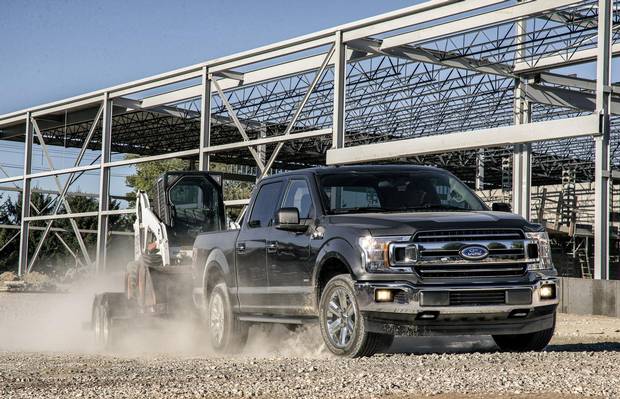Power and capability lie at the core of any pickup truck, but what I'm experiencing in a 2018 Ford F-150 is more akin to godlike omnipotence.
It's not the rumbling EcoBoost V-6 under the hood: I'm doing less than 10 km/h. The source of my I-can-do-anything confidence is a small dial on the dashboard. Lightly twirling it with my finger and thumb, I back up a trailer hauling a 23-foot powerboat around a curve and down a narrow boat ramp. I've never done anything like this before. I nail it the first time.
While I simply use the dial to "steer" where I want the trailer to go, the ghost in the machine autonomously spins the real steering wheel this way and that to achieve the desired effect.
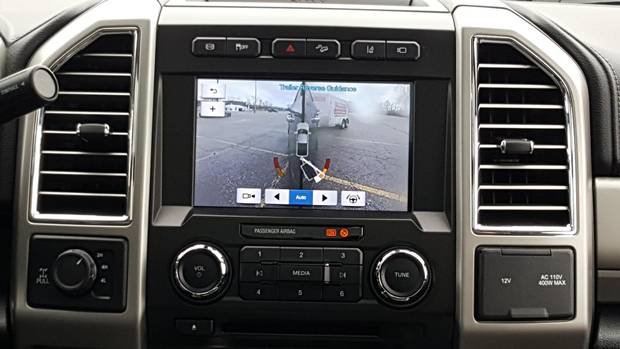
The backup assist technology offers an overhead view.
TOM MALONEY/THE GLOBE AND MAIL
Pro Trailer Backup Assist is just one of the innovations Ford keeps adding to the F-150, Canada's top-selling pickup for 51 years. This particular feature dates back to 2016, but it's still exclusive to Ford. For 2018, it's joined by available adaptive cruise with stop-and-go and precollision assist with pedestrian detection – more firsts for Ford in a segment that is habitually slow to add automated driver aids.
Other full-size pickups also list powerful engines and take turns at claiming this year's best-in-class toting or towing ratings. Each has its own fiercely loyal customer base. But Ford's customer base is consistently bigger, and Ford achieves its dominance with less "my-grille-is-bigger-than-your-grille" posturing.
Todd Eckert, Ford's truck brand marketing manager, says the F-150 has a different – albeit perhaps just a tad pretentious – owner profile. Typical F-150 drivers are "pillars of their communities," he says, adding that they are "the go-to person that everybody turns to when they need something," and they lead multidimensional lives.
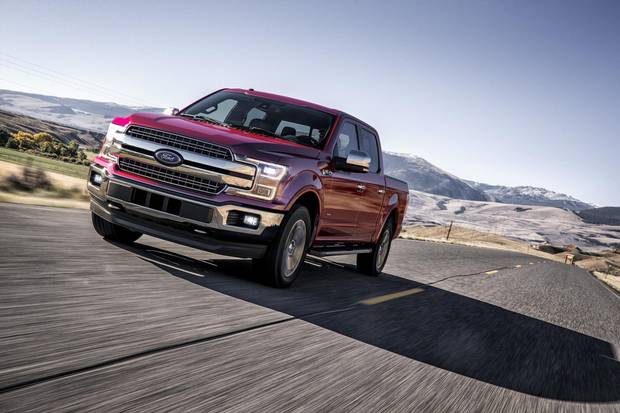
The updated F-150 features new C-clamp headlights.
FORD
Fittingly, the 2018 cosmetic enhancements emphasize the F-truck's width, rather than intimidate other drivers with hulking bulk. Note the new "C-clamp headlights that hold the grille in place like a machine puzzle piece," as design manager Sean Tant describes it. The new face also establishes a family connection with the new Super Duty.
Of course, under it all lies the same aluminum sheet-metal on which Ford bet the farm – and apparently won – in 2015.
Mechanically, the headliner for 2018 is an available diesel, though here Ford is playing catch-up with Ram, which has offered one since 2014. Ford's 3.0-litre V-6 turbo-diesel isn't ready for press time yet (it goes on sale next spring), but the gas-engine lineup is plenty newsworthy, too.
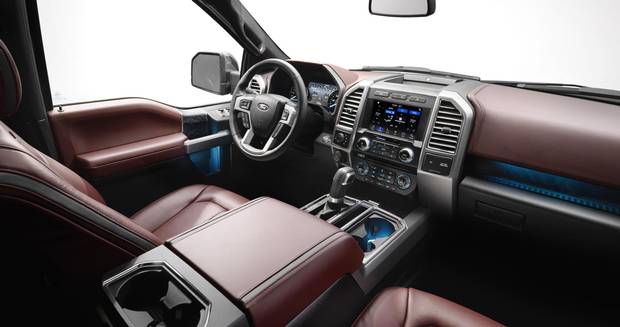
The interior of the 2018 Ford F-150.
Following the Gen-2 upgrades introduced on the 2017 3.5-litre EcoBoost V-6, the same treatment has been applied to the base V-6 (which also gets downsized to 3.3 from 3.5 litres) as well as the 2.7-litre EcoBoost V-6 and the non-turbo 5.0-litre V-8. The 2.7 and 5.0 also get to share the 3.5's new 10-speed transmission (the 3.3 stays six-speed).
A common and key novelty on all the gas engines is dual port and direct fuel-injection. Already used on some Toyotas, this "twinjection" strategy enables best-of-both-worlds gains in both power and fuel economy. Port injection (upstream of the intake valves) provides better fuel atomization (for example, a finer spray that is better mixed with the intake air) at low loads, says powertrain chief engineer Peter Dowding; direct injection (into the combustion chambers) takes over at higher loads, which "allows us to cool down the incoming charge, which increases the density, which means we can get more power and more torque."
As well, Dowding says, with two separate sets of injectors, each can be optimized for its own narrower set of operating conditions, allowing finer control than one injector size having to span the whole range.
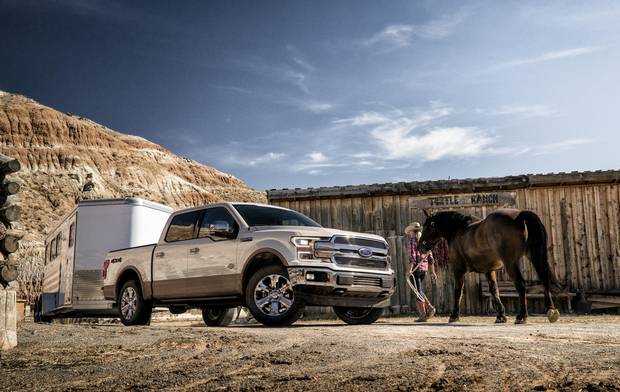
The all-new 3.3-liter V6 delivers even more power, torque and better EPA-estimated gas mileage than the previous 3.5-liter V6.
FORD
But he denies that adding port injection is connected to reports of premature carbon build-up on some DI engines.
Power and torque grow by 3 to 5 per cent for the 3.3 V-6 and 5.0 V-8; the 2.7 EcoBoost V-6's peak power is unchanged, but torque is fattened by 7 per cent. Fuel economy – helped also by the more-speed transmission and standard idle stop/start – improves almost across the board, mostly in the 3- to 8-per-cent range, depending on model and driving mode. As ever, real-world results may vary.
The 3.5 EcoBoost carries over unchanged, but thusly equipped. The F-150's maximum tow rating has edged up to 13,200 pounds. That's best in class, natch … for now.
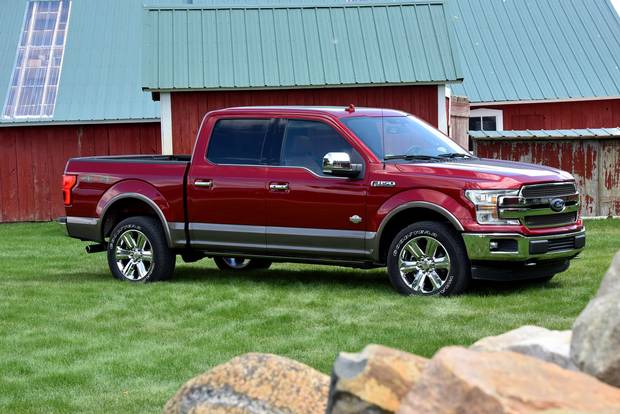
The 2.7 V-6 doesn’t feel much slower than the 3.5 EcoBoost.
FORD
Last year's reboot gave the 3.5 a delicious V-8-like soundtrack to go with its equally V-8-like performance, and that doesn't change for 2018. You almost wonder why Ford keeps an actual V-8 in the lineup, especially a relatively small-displacement one that's handsomely out-torqued by the 3.5 turbo V-6. Even the 2.7 V-6 beats the 5.0 for useable low-end torque (same 400 lb-ft, but at much lower rpm), and doesn't feel much slower than the 3.5 EcoBoost. In my hands, the 2.7 showed 10.4 litres/100 km over the 60-kilometre rural test route, versus 12.7 in the V-8.
My own lifestyle doesn't need a pickup, and my ego doesn't need to drive high-and-mighty. Full-size pickups take up too much space and still consume too much gas. Yet despite my official disapproval, I've never met a modern F-150 that I didn't enjoy driving. Apparently, beneath my mild-mannered exterior, even I have a taste for power and control.
The writer was a guest of the auto maker. Content was not subject to approval.
Shopping for a new car? Check out the new Globe Drive Build and Price Tool to see the latest discounts, rebates and rates on new cars, trucks and SUVs. Click here to get your price.
